人教版(2019)必修 第一册Welcome Unit Discovering Useful Structures 课件 (共29张PPT)
文档属性
| 名称 | 人教版(2019)必修 第一册Welcome Unit Discovering Useful Structures 课件 (共29张PPT) | 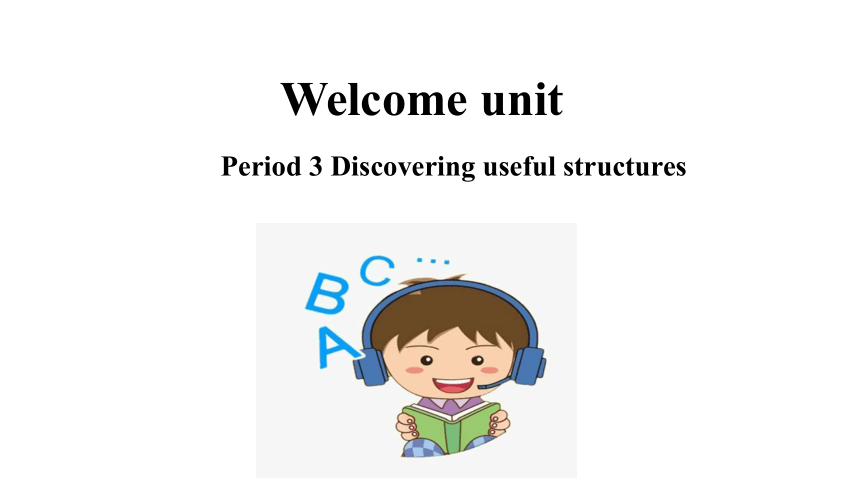 | |
| 格式 | ppt | ||
| 文件大小 | 1.8MB | ||
| 资源类型 | 教案 | ||
| 版本资源 | 人教版(2019) | ||
| 科目 | 英语 | ||
| 更新时间 | 2024-07-23 22:55:25 | ||
图片预览

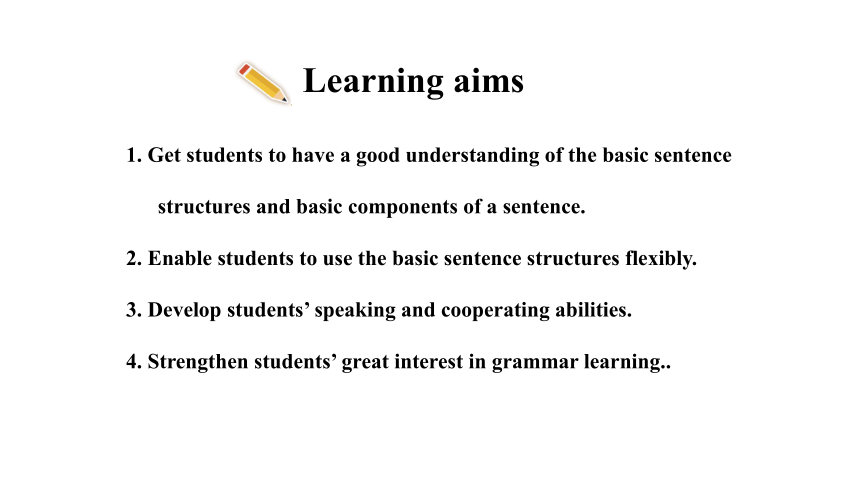
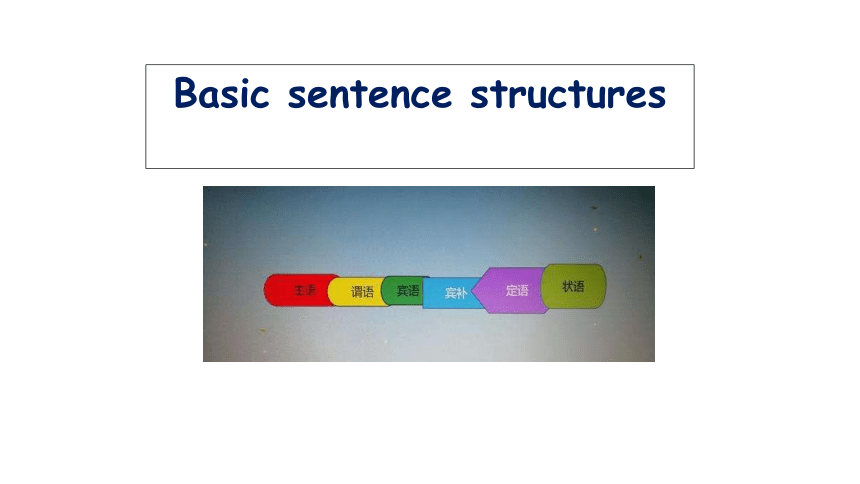
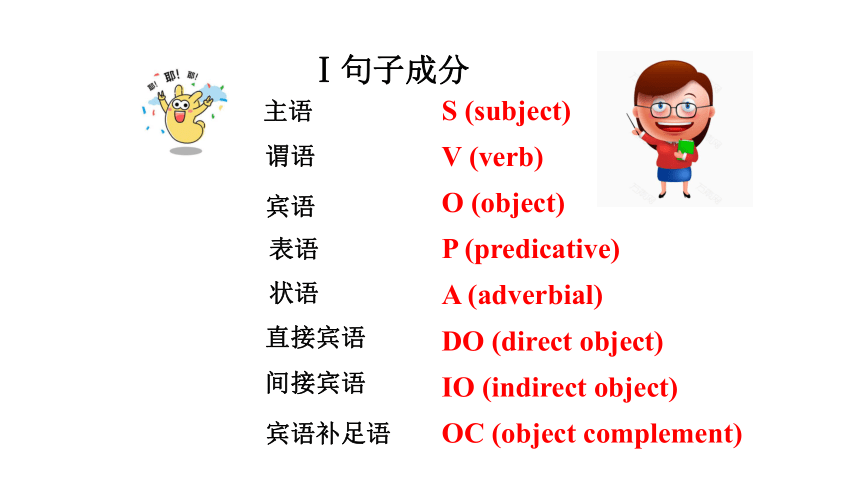
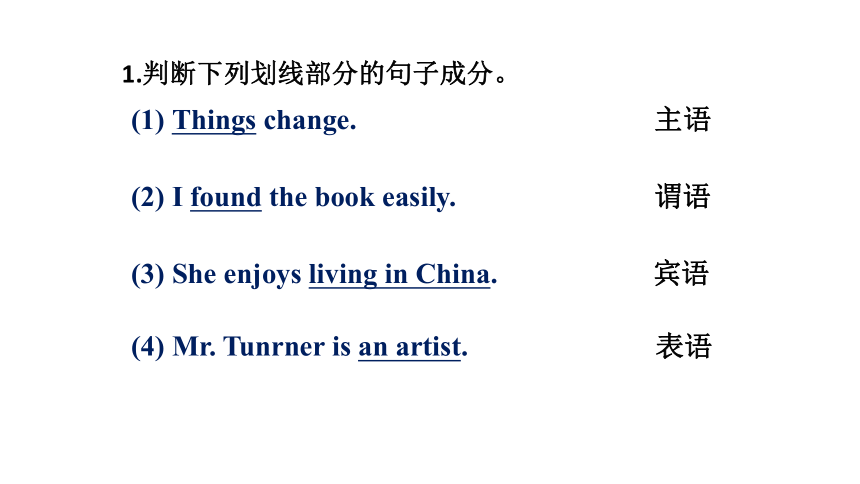

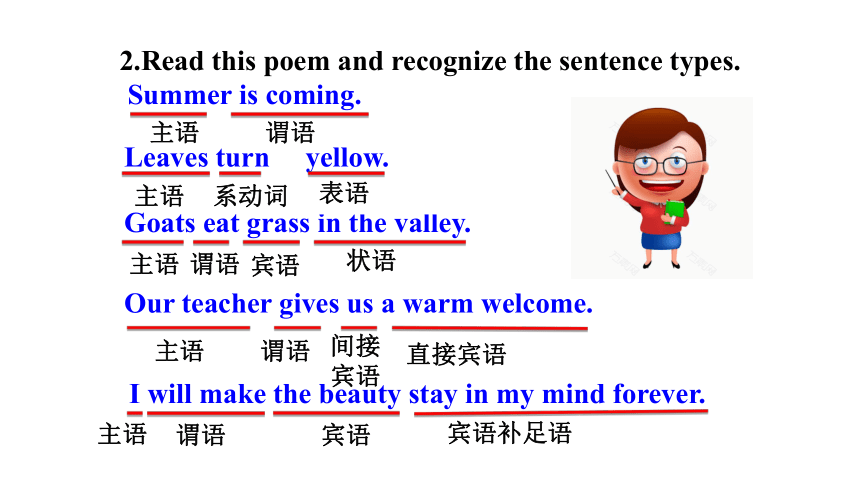
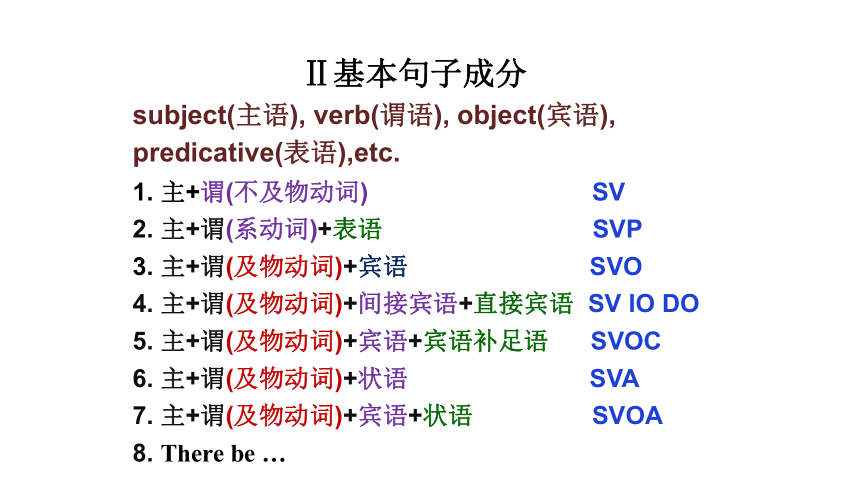
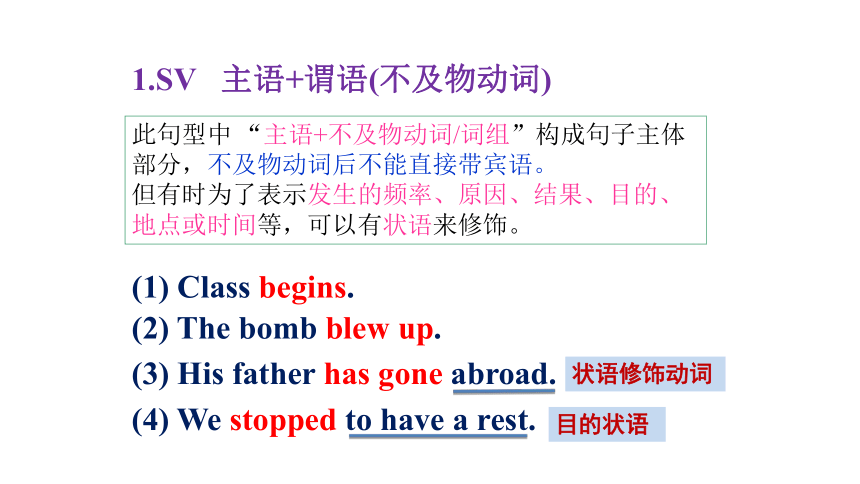
文档简介
(共29张PPT)
Period 3 Discovering useful structures
Welcome unit
1. Get students to have a good understanding of the basic sentence structures and basic components of a sentence.
2. Enable students to use the basic sentence structures flexibly.
3. Develop students’ speaking and cooperating abilities.
4. Strengthen students’ great interest in grammar learning..
Learning aims
Basic sentence structures
谓语
主语
表语
宾语
间接宾语
宾语补足语
直接宾语
状语
S (subject)
V (verb)
O (object)
P (predicative)
A (adverbial)
DO (direct object)
IO (indirect object)
OC (object complement)
Ⅰ句子成分
(2) I found the book easily.
(3) She enjoys living in China.
宾语
谓语
1.判断下列划线部分的句子成分。
(1) Things change.
主语
(4) Mr. Tunrner is an artist.
表语
(6) I will tell you a good news.
宾语补足语
(7) They named the girl Marry.
间接宾语+直接宾语
(5) He knows a lot.
状语
Summer is coming.
Leaves turn yellow.
Goats eat grass in the valley.
Our teacher gives us a warm welcome.
I will make the beauty stay in my mind forever.
主语
谓语
主语
主语
主语
主语
系动词
谓语
谓语
谓语
表语
宾语
间接宾语
宾语补足语
宾语
直接宾语
状语
2.Read this poem and recognize the sentence types.
subject(主语), verb(谓语), object(宾语), predicative(表语),etc.
1. 主+谓(不及物动词) SV
2. 主+谓(系动词)+表语 SVP
3. 主+谓(及物动词)+宾语 SVO
4. 主+谓(及物动词)+间接宾语+直接宾语 SV IO DO
5. 主+谓(及物动词)+宾语+宾语补足语 SVOC
6. 主+谓(及物动词)+状语 SVA
7. 主+谓(及物动词)+宾语+状语 SVOA
8. There be …
Ⅱ基本句子成分
1.SV 主语+谓语(不及物动词)
此句型中 “主语+不及物动词/词组”构成句子主体部分,不及物动词后不能直接带宾语。
但有时为了表示发生的频率、原因、结果、目的、地点或时间等,可以有状语来修饰。
(1) Class begins.
(3) His father has gone abroad.
(4) We stopped to have a rest.
状语修饰动词
目的状语
(2) The bomb blew up.
2.SVO 主语+谓语(及物动词)+宾语
此句型中谓语是及物动词,其后必须跟宾语才能使句意表达完整。
注意:一些不及物动词后面加介词相当于一个及物动词,之后可加宾语。
(1)You must listen to me.
(2)He arrived in London yesterday.
(3)She is laughing at the crippled man.
(4)I’ll write about my volleyball team in my future books.
词性 例句
He has formed the habit of rising early in the morning.
Have you told them anything about the accident
If you add 5 to 5, you get 10.
We may find out the unknown by calculation.
可在句中充当宾语的成分
名词
代词
数词
名词化的形容词
由……充当 例句
I dislike travelling to work in a very crowded bus every day.
He refused to attend the medical conference.
I wonder whether I should stay or not.
可在句中充当宾语的成分
V-ing(短语)
不定式(短语)
从句
特殊疑问词+不定式
She knows what to do next.
3. SVP 主语+系动词+表语
此类型的句子,谓语动词不能表达一个完整的意思,必须加上一个表明主语性质或状态的表语,才能表达完整的意思。
1)He became a scientist.
2)My sister is out now.
3)Dinner smells good.
常见的系动词:
be动词类:am, is , are , was, were
表示变化类:become, get, turn, grow, go
感官动词类:look, sound, smell, taste, feel
表示延续性的动词:remain, stay, keep
My pen is on the table.
They grow mature as they grow.
His plan sounded good.
He remains kind to those around him.
4. SV IO DO
主语+谓语(及物动词)+间接宾语+直接宾语
I bought John a birthday present.
间接宾语
直接宾语
I showed him my pictures.
间接宾语
直接宾语
常用于双宾语结构的动词有:
award (授予某人…), buy(给某人买…),bring(带给某人…), get(给某人弄到…), give(给某人…), hand(递给某人…), lend(借给某人……), leave(留给某人… ),
pay(支付某人…) , pass(递给某人…), read(给某人读……), rent(租赁某人……), recommend(将某人推荐给……) , send(送给某人…), show(给某人看…),tell(告诉某人…), take(给某人拿…), teach(教某人…) , write(给某人写…)等。
5.主语+谓语(及物动词)+宾语+宾语补足语
在某些及物动词的后面,需要用一个宾语再加一个宾补才能表达完整的意思。
We elected him our monitor.
我们选他当班长。
The news made me happy.
那消息使我很高兴。
常带复合宾语结构的及物动词有:
ask(请求,要求) , allow(容许) ,appoint(任命) , cause(使得) , catch(发现) , consider(认为) ,
elect(选举) , expect(预期) , feel(感觉到) ,
find(发现) , get(使得) , have(使,让) ,
hear(听到) ,let(使) , listen to(听) , look at(看,瞧) , make(使) , notice(注意到) , see(看见) ,
smell(闻到) , start(使……开始) , watch(注视,看) , think(想,认为) , want(想要) , wish(希望)等等。
6. SVA主+谓(及物动词)+状语
主谓是句子中不可缺少的成分,状语是一种修饰成分,用于修饰动词、短语和句子。
I have been waiting for more than half an hour.
我已经等了半个多小时。
The children stayed in room.
孩子们待在屋里。
7. SVOA主+谓(及物动词)+宾语+状语
主谓宾是句子中不可缺少的成分,状语是一种修饰成分,用于修饰动词、短语和句子。
Many people eat noddles in Chinese restaurants in London.在伦敦,许多人在中国面馆吃面条。
You can solve the problem in this way.
你可以用这种方法解决这个问题。
8. There be…
There are three people in my family.
我家有三口人。
There was a sports meeting in our school yesterday.
我们学校昨天举办了运动会。
(2022·全国乙卷) And there were traffic jams, too. 并且有交通拥堵的情况。
(1)They all laughed!
(2)I miss my teacher.
(3)The man was kind and friendly.
(4)She told us a funny story.
(5)I found most of my classmates and teachers friendly and helpful.
主语+谓语 (SV)
主语+谓语+宾语 (SVO)
主语+谓语+表语 (SVP)
主语+谓语+间接宾语+直接宾语 (SV IO DO)
主语+谓语+宾语+宾补 (SVOC)
1.Read and point out their sentence types.
(6)He ate too much.
(7)I had my first English class at primary school.
(8)There’s much for me to do.
主语+谓语+状语 (SVA)
主语+谓语+宾语 +状语(SVOA)
There be句型
2.Read the sentences and analyse the structures.
(1) The 100-year-old school lies in the centre of the city.
(2) We must act.
(3) The maths homework looks easy.
(4) The teacher found the classroom empty.
S
V
A
S
V
S
P
S
V
O
C
P6 2
(5) My mum bought me a new dictionary.
(6) Tom is looking forward to meeting the new
exchange student.
(7) There is an English Corner at our school.
(8) We had chemistry in the newly built lab.
S
V
IO
DO
S
V
O
There be 句型
S
V
O
A
(9) That dream has come true!
(10) Tim and his classmates are living on a ship!
(11) They also learn about ships and the sea.
S
V
S
V
S
V
A
O
P6 3
(12) Tim writes his parents an email every week and tells them what happened on the ship.
(13) Studying and doing homework seem
much more fun.
S
V
IO
DO
V
IO
S
V
P
DO
句子成分
主语、谓语、宾语、表语、状语、直接宾语、间接宾语、补语
Summary
八大基本句型
1. 主+谓(不及物动词)
2. 主+谓(系动词)+表语
3. 主+谓(及物动词)+宾语
4. 主+谓(及物动词)+间接宾语+直接宾语
5. 主+谓(及物动词)+宾语+宾语补足语
6. 主+谓(及物动词)+状语
7. 主+谓(及物动词)+宾语+状语
8. There be …
句子成分分析
Victory won't come to me unless I go to it.
胜利是不会向我走来的,我必须自己走向胜利。
Period 3 Discovering useful structures
Welcome unit
1. Get students to have a good understanding of the basic sentence structures and basic components of a sentence.
2. Enable students to use the basic sentence structures flexibly.
3. Develop students’ speaking and cooperating abilities.
4. Strengthen students’ great interest in grammar learning..
Learning aims
Basic sentence structures
谓语
主语
表语
宾语
间接宾语
宾语补足语
直接宾语
状语
S (subject)
V (verb)
O (object)
P (predicative)
A (adverbial)
DO (direct object)
IO (indirect object)
OC (object complement)
Ⅰ句子成分
(2) I found the book easily.
(3) She enjoys living in China.
宾语
谓语
1.判断下列划线部分的句子成分。
(1) Things change.
主语
(4) Mr. Tunrner is an artist.
表语
(6) I will tell you a good news.
宾语补足语
(7) They named the girl Marry.
间接宾语+直接宾语
(5) He knows a lot.
状语
Summer is coming.
Leaves turn yellow.
Goats eat grass in the valley.
Our teacher gives us a warm welcome.
I will make the beauty stay in my mind forever.
主语
谓语
主语
主语
主语
主语
系动词
谓语
谓语
谓语
表语
宾语
间接宾语
宾语补足语
宾语
直接宾语
状语
2.Read this poem and recognize the sentence types.
subject(主语), verb(谓语), object(宾语), predicative(表语),etc.
1. 主+谓(不及物动词) SV
2. 主+谓(系动词)+表语 SVP
3. 主+谓(及物动词)+宾语 SVO
4. 主+谓(及物动词)+间接宾语+直接宾语 SV IO DO
5. 主+谓(及物动词)+宾语+宾语补足语 SVOC
6. 主+谓(及物动词)+状语 SVA
7. 主+谓(及物动词)+宾语+状语 SVOA
8. There be …
Ⅱ基本句子成分
1.SV 主语+谓语(不及物动词)
此句型中 “主语+不及物动词/词组”构成句子主体部分,不及物动词后不能直接带宾语。
但有时为了表示发生的频率、原因、结果、目的、地点或时间等,可以有状语来修饰。
(1) Class begins.
(3) His father has gone abroad.
(4) We stopped to have a rest.
状语修饰动词
目的状语
(2) The bomb blew up.
2.SVO 主语+谓语(及物动词)+宾语
此句型中谓语是及物动词,其后必须跟宾语才能使句意表达完整。
注意:一些不及物动词后面加介词相当于一个及物动词,之后可加宾语。
(1)You must listen to me.
(2)He arrived in London yesterday.
(3)She is laughing at the crippled man.
(4)I’ll write about my volleyball team in my future books.
词性 例句
He has formed the habit of rising early in the morning.
Have you told them anything about the accident
If you add 5 to 5, you get 10.
We may find out the unknown by calculation.
可在句中充当宾语的成分
名词
代词
数词
名词化的形容词
由……充当 例句
I dislike travelling to work in a very crowded bus every day.
He refused to attend the medical conference.
I wonder whether I should stay or not.
可在句中充当宾语的成分
V-ing(短语)
不定式(短语)
从句
特殊疑问词+不定式
She knows what to do next.
3. SVP 主语+系动词+表语
此类型的句子,谓语动词不能表达一个完整的意思,必须加上一个表明主语性质或状态的表语,才能表达完整的意思。
1)He became a scientist.
2)My sister is out now.
3)Dinner smells good.
常见的系动词:
be动词类:am, is , are , was, were
表示变化类:become, get, turn, grow, go
感官动词类:look, sound, smell, taste, feel
表示延续性的动词:remain, stay, keep
My pen is on the table.
They grow mature as they grow.
His plan sounded good.
He remains kind to those around him.
4. SV IO DO
主语+谓语(及物动词)+间接宾语+直接宾语
I bought John a birthday present.
间接宾语
直接宾语
I showed him my pictures.
间接宾语
直接宾语
常用于双宾语结构的动词有:
award (授予某人…), buy(给某人买…),bring(带给某人…), get(给某人弄到…), give(给某人…), hand(递给某人…), lend(借给某人……), leave(留给某人… ),
pay(支付某人…) , pass(递给某人…), read(给某人读……), rent(租赁某人……), recommend(将某人推荐给……) , send(送给某人…), show(给某人看…),tell(告诉某人…), take(给某人拿…), teach(教某人…) , write(给某人写…)等。
5.主语+谓语(及物动词)+宾语+宾语补足语
在某些及物动词的后面,需要用一个宾语再加一个宾补才能表达完整的意思。
We elected him our monitor.
我们选他当班长。
The news made me happy.
那消息使我很高兴。
常带复合宾语结构的及物动词有:
ask(请求,要求) , allow(容许) ,appoint(任命) , cause(使得) , catch(发现) , consider(认为) ,
elect(选举) , expect(预期) , feel(感觉到) ,
find(发现) , get(使得) , have(使,让) ,
hear(听到) ,let(使) , listen to(听) , look at(看,瞧) , make(使) , notice(注意到) , see(看见) ,
smell(闻到) , start(使……开始) , watch(注视,看) , think(想,认为) , want(想要) , wish(希望)等等。
6. SVA主+谓(及物动词)+状语
主谓是句子中不可缺少的成分,状语是一种修饰成分,用于修饰动词、短语和句子。
I have been waiting for more than half an hour.
我已经等了半个多小时。
The children stayed in room.
孩子们待在屋里。
7. SVOA主+谓(及物动词)+宾语+状语
主谓宾是句子中不可缺少的成分,状语是一种修饰成分,用于修饰动词、短语和句子。
Many people eat noddles in Chinese restaurants in London.在伦敦,许多人在中国面馆吃面条。
You can solve the problem in this way.
你可以用这种方法解决这个问题。
8. There be…
There are three people in my family.
我家有三口人。
There was a sports meeting in our school yesterday.
我们学校昨天举办了运动会。
(2022·全国乙卷) And there were traffic jams, too. 并且有交通拥堵的情况。
(1)They all laughed!
(2)I miss my teacher.
(3)The man was kind and friendly.
(4)She told us a funny story.
(5)I found most of my classmates and teachers friendly and helpful.
主语+谓语 (SV)
主语+谓语+宾语 (SVO)
主语+谓语+表语 (SVP)
主语+谓语+间接宾语+直接宾语 (SV IO DO)
主语+谓语+宾语+宾补 (SVOC)
1.Read and point out their sentence types.
(6)He ate too much.
(7)I had my first English class at primary school.
(8)There’s much for me to do.
主语+谓语+状语 (SVA)
主语+谓语+宾语 +状语(SVOA)
There be句型
2.Read the sentences and analyse the structures.
(1) The 100-year-old school lies in the centre of the city.
(2) We must act.
(3) The maths homework looks easy.
(4) The teacher found the classroom empty.
S
V
A
S
V
S
P
S
V
O
C
P6 2
(5) My mum bought me a new dictionary.
(6) Tom is looking forward to meeting the new
exchange student.
(7) There is an English Corner at our school.
(8) We had chemistry in the newly built lab.
S
V
IO
DO
S
V
O
There be 句型
S
V
O
A
(9) That dream has come true!
(10) Tim and his classmates are living on a ship!
(11) They also learn about ships and the sea.
S
V
S
V
S
V
A
O
P6 3
(12) Tim writes his parents an email every week and tells them what happened on the ship.
(13) Studying and doing homework seem
much more fun.
S
V
IO
DO
V
IO
S
V
P
DO
句子成分
主语、谓语、宾语、表语、状语、直接宾语、间接宾语、补语
Summary
八大基本句型
1. 主+谓(不及物动词)
2. 主+谓(系动词)+表语
3. 主+谓(及物动词)+宾语
4. 主+谓(及物动词)+间接宾语+直接宾语
5. 主+谓(及物动词)+宾语+宾语补足语
6. 主+谓(及物动词)+状语
7. 主+谓(及物动词)+宾语+状语
8. There be …
句子成分分析
Victory won't come to me unless I go to it.
胜利是不会向我走来的,我必须自己走向胜利。
